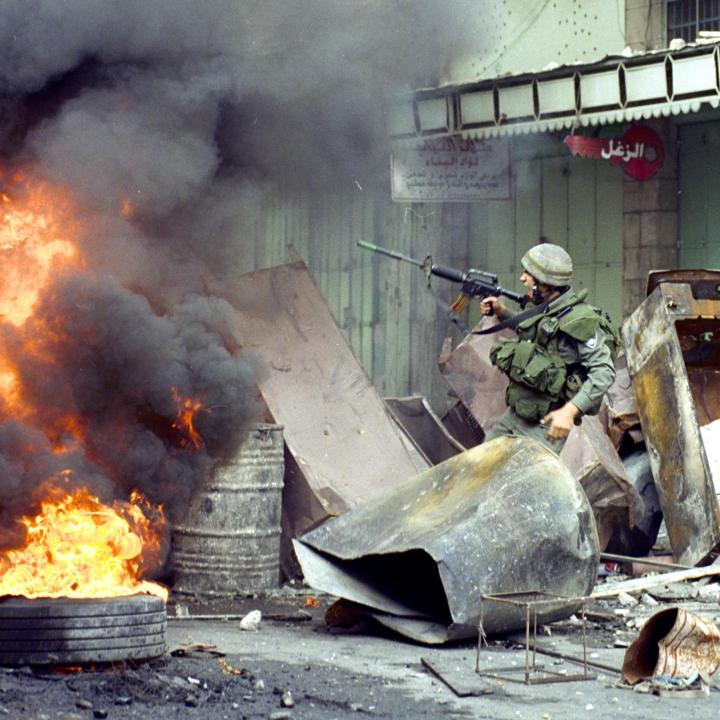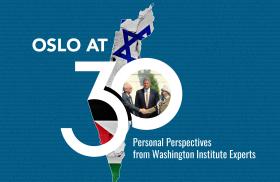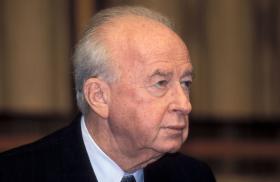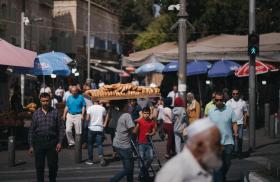
- Policy Analysis
- Fikra Forum
The Implications of the Second Intifada on Israeli Views of Oslo

Part of a series: Oslo at 30
or see Part 1: Oslo at 30: Personal Perspectives from Washington Institute Scholars A Compendium
The sense of helplessness that deepened during the course of the intifada was also accompanied by the need to find a source of the blame. In the eyes of the Israeli public, that blame was placed squarely on Palestinian leadership.
On September 28, 2000, just seven years after the signing of the Oslo Accords, the second intifada broke out. Over the course of five years (2000-2005), Israel faced hundreds of terror attacks and attempted attacks, including several dozen suicide bombings in the heart of the cities. As a result, more than 1200 Israeli citizens lost their lives and thousands more were injured. The attacks triggered Israel’s re-entry into Palestinian cities in Area A with the IDF to restore order and reduce the level of terrorism, negating the withdrawal that had been initiated through Oslo. And for Israelis, these years became the main stumbling block to the Oslo process, leaving it stuck in its initial stage years after a peace settlement was supposed to have been achieved.
I have served in various roles in the Israeli intelligence and security community, during which I have had dozens of professional and friendly conversations with my American and European counterparts. There was a prevailing trend in these conversations; almost all of them underestimated the impact of the second intifada on Israeli society and the erosion of trust among millions of Israelis in Palestinians—an attitude that could not be corrected quickly and has subsequently influenced all later attempts to negotiate piece.
The impact of this period on Israeli society is pervasive: for Israeli adults, the second intifada is remembered as a period of pervasive fear for their children after dropping them off at school, never knowing whether their child’s school was the target of a suicide bomber when they heard warning of attacks through the media.
The sense of helplessness that deepened during the course of the intifada was also accompanied by the need to find a source of the blame. In the eyes of the Israeli public, that blame was placed squarely on Palestinian leadership. According to the Israeli public, the PLO had received international and Israeli recognition through Oslo, but chose to channel their funds and political legitimacy toward bloodshed and terrorism rather than economic development and support for the Palestinian people.
Leading up to the Intifada, Israeli extremists’ efforts to stop the Oslo process had not been successful. After Prime Minister Yitzhak Rabin was assassinated by a Jewish-Israeli terrorist in 1995 to stop the Oslo process, Shimon Peres continued his path and pursued the implementation of the Oslo agreement as de facto prime minister until the elections. When Benjamin Netanyahu was elected in 1996, he also continued Oslo, including by returning the territory of Hebron to the Palestinians from January 17-19, 1997.
Ehud Barak, elected in 1999, likewise met with Arafat under the auspices of President Clinton for the Camp David summit (July 2000), although the efforts failed for a variety of well-documented reasons. Not least among these, however, was that Arafat was preparing an alternative strategy—to promote violence in the West Bank in order to put pressure on the Israelis to make additional territorial concessions.
A preliminary signal for Israelis of what was to come was the violence that followed the opening of the Western Wall (Hakotel) tunnel in September 1996, when Arafat called on Palestinians to violently oppose the Israeli move during the three days of fighting. The IDF was caught off guard when Palestinians—including the Palestinian police force established through Oslo—opened fire. Seventeen IDF soldiers were killed, including a Colonel, and at least 59 Palestinians were killed along with many more injured. As a result, the IDF reversed its initial accommodating post-Oslo approach to the Palestinians and their security services, subsequently viewing them as rivals rather than as partners.
About four months before the outbreak of the second intifada, on June 1, 2000, I was given responsibility and command of a counterterrorism arena in the military intelligence branch of the IDF (Amman). From this vantage point, I came to see the extent that violence and terrorism were part of the strategy of Palestinian leadership, especially of its leader at the time—Yasir Arafat. From this vantage point, I realized that the second intifada is what stopped the Oslo process and reconciliation between Israelis and Palestinians.
About a year after the outbreak of the second intifada, the United States was hit by the largest and deadliest act of terrorism ever—September 11, 2001 (an act unrelated to the Palestinians but dramatically affected the Oslo process) and began the global war on terror. At this point, the United States lost patience for those who support terrorism, including the Palestinian Authority at the time.
Meanwhile, the spiral of violence continued in the early 2000s. The IDF’s Operation "Protective Wall" (April 2002) began on the same night that a Palestinian suicide bomber blew himself up in what Israelis called the "Seder Night Massacre" at the Park Hotel in Netanya. Thirty Israelis celebrating Passover were killed and dozens more civilians were injured. The IDF received instructions from Prime Minister Sharon and retook control of the Palestinian cities in Area A that had been transferred to Palestinian control only a few years earlier. With this act, circumstances on the ground in the West Bank froze in a dynamic that would shape the subsequent twenty years.
Sharon, however, did advance his disengagement plan right after the second intifada. Israel decided for the first time since 1967 to close down settlements, evacuating all settlement and IDF presence from the Gaza Strip, although this action was taken unilaterally and not tied to a diplomatic or international process. The fall of the Gaza Strip to Hamas in 2007 only added to the political and practical death of Oslo. The Palestinian system was divided into two separate Palestinian entities while further solidifying the idea among many Israelis that the consequences of giving up territory was more terrorism.
Over the years, Hamas as a terrorist organization has managed to build a huge arsenal in the Gaza Strip, which includes tens of thousands of rockets and missiles capable of reaching the centers of Israeli cities and hitting Israeli citizens. Hamas has conducted numerous heavy rounds of armed conflict by launching these rockets at civilian targets. In response, the IDF has launched several operation to suppress Hamas, including the 2008 "Cast Lead", 2012 "Pillar of Cloud", 2014 "Protective Edge", 2021 "Guardian of Walls" and others. Yet as far as the Israeli public is concerned, Gaza remains a dangerous vulnerability without any solution.
In the West Bank, the stagnation and corruption of the PA leadership under Mahmoud Abbas has left Israel with limited options for negotiations and Palestinians without a say in their own future. Abbas was elected in 2005 and the 2006 legislative elections were never fully realized after Hamas won the majority of seats. Consequently, a younger generation has been unable to develop or produce an alternative to the existing leadership. The PA also failed to develop institutions of governance after Abbas forced out former prime minister Salam Fayad. The economic dependence on Israel and on the financial contributions of the international community has inhibited any growth originally envisioned. In consequence, the Palestinian public also suffered as a result of the second intifada, since it inhibited any of the political or economic developments envisioned by Oslo.
Oslo laid the initial foundation for a territorial settlement between Israel and the Palestinians, which was carried out fully in Gaza and partly in the West Bank. But it failed to create two entities living side by side in peace, and split the Palestinian entity in two. Beyond the physical dimensions of the conflict, the psychological effects on both societies of the initial hopes of Oslo followed by the trauma of the intifada ironically had similar effects. For Israelis, it killed the idea of peace through territorial concessions. For Palestinians, the idea of political gain through violent resistance failed, at least for the time being. Even so, the best hope is for Israel to one day reach a decision for a separation of the two peoples with international recognition of the outcome, unlike what occurred with the Gaza disengagement.





